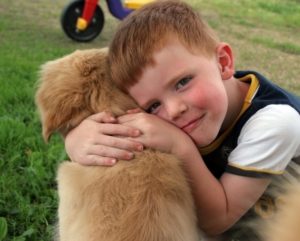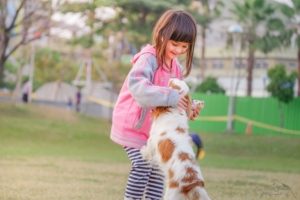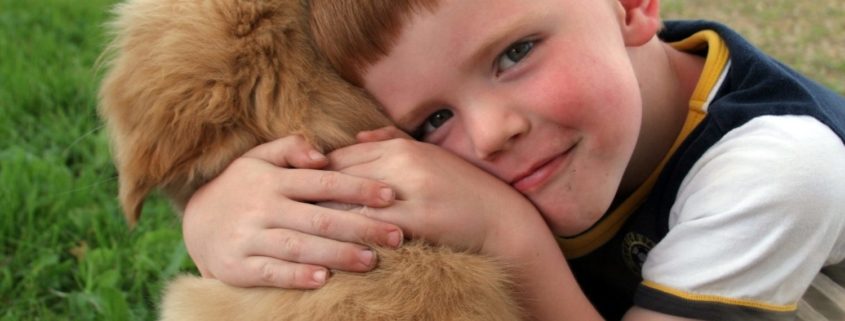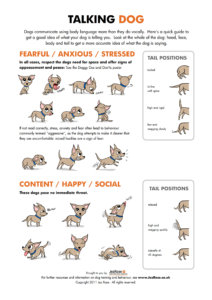Ask Crystal: Harmony between Puppies and Kids
Welcome to “Ask Crystal,” where you can ask your pet behavior questions! You can submit your question for Crystal at the bottom of the page!

Dear Crystal,
I don’t know what to do. I have two children under 4 years old. My puppy seems like she doesn’t like my kids very much and sometimes she plays way too rough with them. She is getting so big and scratching them all over. Yesterday, I think she might have knocked my son over. I don’t know what happened but when I came in the room he was crying. What can I do to keep my kids safe?
Sincerely,
Overwhelmed Mom
Dear Overwhelmed,
Many people have fond memories of growing up with dogs, so it seems very natural to adopt a puppy to live with your kids. People have fantasies of the kids and dogs doing all sorts of adorable things together. A lot of times kids and dogs do have that type of relationship but whether or not that is your reality is going to depend on a lot of factors.
It is important when selecting a dog or puppy that she really loves the kids. A dog that adores children is going to put up with a lot more than a dog that simply tolerates children. Not that I am advocating children being rude with dogs but it is likely to happen to an extent so why not choose a dog that isn’t as bothered by it. I do not recommend a dog that seems to be fearful of children, handling or loud noises. A dog like this is likely to be very bothered by normal kid activities, may act out aggressively and in general not be happy in a home with kids.
Dog professionals have been beating parents over the head with the advice to supervise, supervise, supervise for years. I completely agree that you need to be supervising at all times when dog and child are interacting. However, many people don’t know what they should be looking for and when to intervene. Just having had dogs for most of your life does not by virtue teach you how to read dog body language. In fact, most dog bites occur when a parent is directly supervising. The good news is that you can learn dog body language to help you read your dog’s discomfort and intervene. That is how we keep everyone as safe as possible and develop a relationship between dogs and children.
When looking at dog body language, look at the whole picture. Know that many of these signals can mean different things in different contexts. When you see signals appearing as a grouping in response to something happening in the environment, it is probably stress related. This list is not comprehensive by any means. Some behaviors you may see when your dog is uncomfortable with an interaction: ears back, looking away, yawning, lip licking, half-moon eyes, mouth closed, tightness in the face, suddenly scratching, licking, sniffing. These are the beginning signals that most people miss. Your dog is looking for help from you. If you miss these signals your dog may try to escape or avoid the children. If that doesn’t work, they will go to more aggressive signals like growling, lunging, barking, snapping and biting. In general, if you provide proper supervision and intervention you should not get to the aggressive signals. If you think your dog loves the interactions, take a picture and examine the body language in detail to be sure. If you look at most pictures on the internet of people interacting with dogs, the dog is often showing a level of discomfort at the interaction.
Different dogs are stressed by different things. They also have different bite thresholds which is the stress level required for that dog to bite. Dogs that are having a rough day or have had a lot of excitement are likely to be stressed or tired. If you think of your dog in the same way you think of your toddler, it can help put you in the right mindset. Your baby is going to get grumpy if they have had a big day whether it was good or bad. Your dog is going to be the same way except he has really sharp teeth. Give your dog breaks in his crate or room when he is showing signs of stress or when there has been a lot of activity.
There are many dogs that will tolerate behaviors that make them feel uncomfortable for a while until they can’t take it anymore and then they bite. Most dogs don’t like to be hugged. Hugging is a primate behavior which is why we can’t seem to stop doing it. Dogs don’t hug each other. Some dogs tolerate it but it isn’t a dog thing. They also don’t want to be ridden like a horse. So many people expect dogs to tolerate everything that we do to them. That is not a fair or realistic expectation and dogs lose their lives because of it every year.
According to the website www.Familypaws.com, there are five levels of supervision:
- Absent is when the adult is not in the room. If we are not in the room, we have no way to monitor interactions with the dog and the child. This is dangerous and we should work to prevent it at all times. Put the dog behind baby gates, close the door or take the dog with you if you need to leave the room.
- Passive supervision is when the adult is in the same location but not watching. Maybe you are answering emails, playing a game on your phone or texting. This is often where the dog is allowed to be approached or handled and the adult is not watching. The dog is showing discomfort but no one is stepping in. Dogs can become uncomfortable with the approach of the child and start to growl before the child even gets to them with time.
- Reactive supervision is responding after the dog or child is too close. People will often yell, “No, no stop!” to the child. That stress that you are projecting is effecting your dog. It can cause a negative association with the child being close to them.
- Proactive supervision is planning and preparing for safe separation. This means a plan for separation and utilizing crates, baby gates, tethers, closing and locking doors, etc. Any moment that you cannot be actively supervising the interactions, use some form of separation. Work to get the dog used to separation right away so she doesn’t have a high level of anxiety when she needs to be separated. Use food enrichment toys to keep her occupied and happy while separated.
- Active supervision is fully awake and present adult supervision.
Toddlers move in ways that can be frightening or stimulating to dogs. They flail their arms at exciting stimuli like dogs. This can be scary to a dog. When allowing toddlers to interact with dogs, I suggest that you do not allow them to touch the dog freely. Hold the baby’s hand in yours and guide their touch. Show them how to pet softly and in the right places like along the back. Babies can put their hand in the dog’s mouth in a moment. Children running and playing can get a young dog very excited. The puppy will often start trying to play with the kids. They may chase, tackle and/or mouth the toddler. This is normal play for a puppy. They don’t understand how they are supposed to play with children. If the kids are getting riled up and running around, maybe it’s time for the puppy to nap in the crate or spend some time in a room with a kong to occupy her. Play with the puppy and tire her out when the kids are napping.
Never punish the dog for growling or showing her discomfort. The behavior is a symptom of the problem, not the problem. You need to make things better for her and then undesirable behaviors will go away. In addition, if you punish out growling and other warning signals, you may stop the warnings but you won’t change how the dog feels. The dog will still be afraid or uncomfortable. You may create a dog that bites without warning which means you will have no way to stop it before it happens.

Dogs and kids can live happily together. I have really fond memories of growing up with dogs. It is the parent’s responsibility to teach kids how to interact with all dogs so that we can keep them safe. Teach your kids how to respect dogs. Teach your dog that she is safe by recognizing her subtle discomfort signals and intervening. It will go a long way to creating a healthy lifelong relationship with your children.
Until next time,
Crystal








